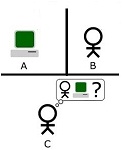Reference no: EM132235187
Problem 1: Draw the non-abbreviated logic diagram
Construct the truth table for each.
a) ((ab)′(b′c)′+ a′b′c′)′
b) ((abc)′ + (a′b′c′)′
c) (a ⊕ b) ⊕ c + ab′c
d) (((a + b)′ + c)′ + ??)′
Problem 2:
Draw a Karnaugh map
Find the minimum AND-OR expression for x(a,b,c,d).
a) Σ(2,4,5,11,13,15)
b) Σ(0,1,2,3,4,5,6,7,8,9,10,11,12,13,14)
Problem 3:
Draw a Karnaugh map
Find the minimum AND-OR expression for x(a,b,c,d) with don't care conditions.
a) Σ(0,3,14) + d(2,4,7,8,10,11,13,15)
b) Σ(1,6,9,12) + d(0,2,3,4,5,7,14,15)
Remember Don't Cares do not have to be circled, but should be used to obtain the largest groupings
Problem 4:

Draw the truth table.
Hint -a, b, & s are the three inputs on your truth table and x & y are the two outputs. Draw 2 K-Maps - one for output of x and one of for output of y
Find & show the minimum AND-OR expressions - one for f(x) and one for f(y) Construct one circuit using only AND, OR, and inverter gates.
Problem 5:
Study Fig 10.57 & 10.58 and apply what you have learned about gates to determine the solution.
Notes:
- The A with the bracket in Fig 10.58 indicates A0 thru A7 from the A bus. Your solution will look similar to Fig 10.58 and will have both the A bus and the B bus as inputs.
- The line on top means NOT so this reads NOT A AND B
- There is a presentation that explains 10.57 & 10.58 named Combinational Circuit Blocks posted in Worked Examples.
Attachment:- Computer Organization and Architecture.rar